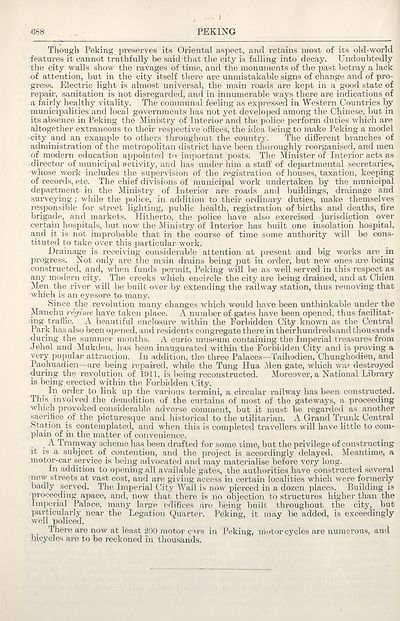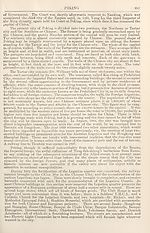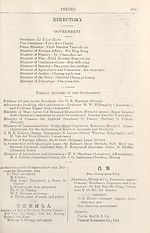1917
(782) Page 688
Download files
Complete book:
Individual page:
Thumbnail gallery: Grid view | List view

•668
PEKING
Though Peking preserves its Oriental aspect, and retains most of its old-world
features it cannot truthfully be said that the city is falling into decay. Undoubtedly
the city walls show the ravages of time, and the monuments of the past betray a lack
of attention, but in the city itself there are unmistakable signs of change and of pro¬
gress. Electric light is almost universal, the main roads are kept in a good state of
repair, sanitation is not disregarded, and in innumerable ways there are indications of
a fairly healthy vitality. The communal feeling as expressed in Western Countries by
municipalities and local governments has not yet developed among the Chinese, but in
its absence in Peking the Ministry of Interior and the police perform duties which are
altogether extraneous to their respective offices, the idea being to make Peking a model
city and an example to others throughout the country. The different branches of
administration of the metropolitan district have been thoroughly reorganised, and men
of modern education appointed to important posts. The Minister of Interior acts as
director of municipal activity, and has under him a staff of departmental secretaries,
whose work includes the supervision of the registration of houses, taxation, keeping
of records, etc. The chief divisions of municipal work undertaken by the municipal
department in the Ministry of Interior are roads and buildings, drainage and
surveying; while the police, in addition to their ordinary duties, make themselves
responsible for street lighting, public health, registration of births and deaths, fire
brigade, and markets. Hitherto, the police have also exercised jurisdiction over
certain hospitals, but now the Ministry of Interior has built one insolation hospital,
and it is not improbable that in the course of time some authority will be cons¬
tituted to take over this particular work.
Drainage is receiving considerable attention at present and big works are in
progress. Not only are the main drains being put in order, but new ones are being
constructed, and, when funds permit, Peking will be as well served in this respect as
any modern city. The creeks which encircle the city are being drained, and at Chien
Men the river will be built over by extending the railway station, thus removing that
which is an eyesore to many.
Since the revolution many changes which would have been unthinkable under the
Manchu regime have taken place. A number of gates have been opened, thus facilitat¬
ing traffic. A beautiful enclosure within the Forbidden City known as the Central
Park has also been opened, and residents congregate there in theirhundredsand thousands
during the summer months. A curio museum containing the Imperial treasures from
Jehol and Mukden, has been inaugurated within the Forbidden City and is proving a
very popular attraction. In addition, the three Palaces—Taihodien, Chunghodien, and
Paohuadien—are being repaired, while the Tung Hua Men gate, which was destroyed
during the revolution of 1911, is being reconstructed. Moreover, a National Library
is being erected within the Forbidden City.
In order to link up the various termini, a circular railway has been constructed.
This involved the demolition of the curtains of most of the gateways, a proceeding
which provoked considerable adverse comment, but it must be regarded as another
sacrifice of the picturesque and historical to the utilitarian. A Grand Trunk Central
Station is contemplated, and when this is completed travellers will have little to com¬
plain of in the matter of convenience.
A Tramway scheme has been drafted for some rime, but the privilege of constructing
it is a subject of contention, and the project is accordingly delayed. Meantime, a
motor-car service is being advocated and may materialise before very long.
In addition to opening all available gates, the authorities have constructed several
.new streets at vast cost, and are giving access in certain localities which were formerly
badly served. The Imperial City Wall is now pierced in a dozen places. Building is
proceeding apace, and, now that there is no objection to structures higher than the
Imperial Palace, many large edifices are being built throughout the city, but
particularly near the Legation Quarter. Peking, it may be added, is exceedingly
well policed.
There are now at least 200 motor cars in Peking, motor cycles are numerous, and
bicycles are to be reckoned in thousands.
PEKING
Though Peking preserves its Oriental aspect, and retains most of its old-world
features it cannot truthfully be said that the city is falling into decay. Undoubtedly
the city walls show the ravages of time, and the monuments of the past betray a lack
of attention, but in the city itself there are unmistakable signs of change and of pro¬
gress. Electric light is almost universal, the main roads are kept in a good state of
repair, sanitation is not disregarded, and in innumerable ways there are indications of
a fairly healthy vitality. The communal feeling as expressed in Western Countries by
municipalities and local governments has not yet developed among the Chinese, but in
its absence in Peking the Ministry of Interior and the police perform duties which are
altogether extraneous to their respective offices, the idea being to make Peking a model
city and an example to others throughout the country. The different branches of
administration of the metropolitan district have been thoroughly reorganised, and men
of modern education appointed to important posts. The Minister of Interior acts as
director of municipal activity, and has under him a staff of departmental secretaries,
whose work includes the supervision of the registration of houses, taxation, keeping
of records, etc. The chief divisions of municipal work undertaken by the municipal
department in the Ministry of Interior are roads and buildings, drainage and
surveying; while the police, in addition to their ordinary duties, make themselves
responsible for street lighting, public health, registration of births and deaths, fire
brigade, and markets. Hitherto, the police have also exercised jurisdiction over
certain hospitals, but now the Ministry of Interior has built one insolation hospital,
and it is not improbable that in the course of time some authority will be cons¬
tituted to take over this particular work.
Drainage is receiving considerable attention at present and big works are in
progress. Not only are the main drains being put in order, but new ones are being
constructed, and, when funds permit, Peking will be as well served in this respect as
any modern city. The creeks which encircle the city are being drained, and at Chien
Men the river will be built over by extending the railway station, thus removing that
which is an eyesore to many.
Since the revolution many changes which would have been unthinkable under the
Manchu regime have taken place. A number of gates have been opened, thus facilitat¬
ing traffic. A beautiful enclosure within the Forbidden City known as the Central
Park has also been opened, and residents congregate there in theirhundredsand thousands
during the summer months. A curio museum containing the Imperial treasures from
Jehol and Mukden, has been inaugurated within the Forbidden City and is proving a
very popular attraction. In addition, the three Palaces—Taihodien, Chunghodien, and
Paohuadien—are being repaired, while the Tung Hua Men gate, which was destroyed
during the revolution of 1911, is being reconstructed. Moreover, a National Library
is being erected within the Forbidden City.
In order to link up the various termini, a circular railway has been constructed.
This involved the demolition of the curtains of most of the gateways, a proceeding
which provoked considerable adverse comment, but it must be regarded as another
sacrifice of the picturesque and historical to the utilitarian. A Grand Trunk Central
Station is contemplated, and when this is completed travellers will have little to com¬
plain of in the matter of convenience.
A Tramway scheme has been drafted for some rime, but the privilege of constructing
it is a subject of contention, and the project is accordingly delayed. Meantime, a
motor-car service is being advocated and may materialise before very long.
In addition to opening all available gates, the authorities have constructed several
.new streets at vast cost, and are giving access in certain localities which were formerly
badly served. The Imperial City Wall is now pierced in a dozen places. Building is
proceeding apace, and, now that there is no objection to structures higher than the
Imperial Palace, many large edifices are being built throughout the city, but
particularly near the Legation Quarter. Peking, it may be added, is exceedingly
well policed.
There are now at least 200 motor cars in Peking, motor cycles are numerous, and
bicycles are to be reckoned in thousands.
Set display mode to:
![]() Universal Viewer |
Universal Viewer | ![]() Mirador |
Large image | Transcription
Mirador |
Large image | Transcription
Images and transcriptions on this page, including medium image downloads, may be used under the Creative Commons Attribution 4.0 International Licence unless otherwise stated. ![]()
| Asian directories and chronicles > 1917 > (782) Page 688 |
|---|
| Permanent URL | https://digital.nls.uk/194542474 |
|---|
| Attribution and copyright: |
|
|---|---|
| Description | Volumes from the Asian 'Directory and Chronicle' series covering 1917-1941, but missing 1919 and 1923. Compiled annually from a multiplicity of local sources and research. They provide listings of each country's active corporations, foreign residents and government agencies of all nationalities for that year, together with their addresses. Content includes: various treaties; coverage of conflicts; currencies and taxes; consular fees; weights and measures; public holidays; festivals and traditions. A source of information for both Western states and communities of foreigners living in Asia. Published by Hongkong Daily Press. |
|---|---|
| Shelfmark | H3.86.1303 |
| Additional NLS resources: |

